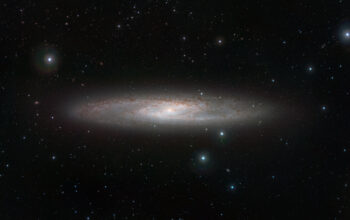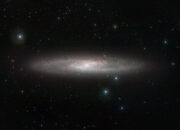Dwarf planets, those enigmatic celestial bodies that inhabit the fringes of our solar system, are characterized by their small size and unique geological features. While the eight recognized planets dominate our planetary neighborhood, dwarf planets beckon us to ponder their significance, particularly as we delve into the obscured realms of the cosmos that lie beyond conventional understanding. Posing a playful question: What role might these diminutive worlds play in the unraveling of cosmic mysteries, particularly within the context of what has been termed the “dark universe”? This inquiry leads us not only into the study of dwarf planets themselves but also encompasses their potential influences on gravitational dynamics, dark matter, and the cosmic web.
To begin, it is imperative to clarify the classification of these celestial bodies. According to the International Astronomical Union (IAU), a dwarf planet is a celestial body that orbits the sun, is not a satellite, has sufficient mass for its self-gravity to overcome rigid body forces, and has not cleared its neighboring region of other objects. Prominent examples of dwarf planets include Pluto, Eris, Haumea, and Makemake. Each offers a unique geological and atmospheric composition, contributing to our overarching understanding of planetary formation and evolution.
In terms of their formation, dwarf planets are believed to originate in the Kuiper Belt and scattered disc, regions rich with icy bodies. Understanding their composition and behavior provides insights into the primordial conditions of the early solar system. For instance, the surface characteristics of dwarf planets, which may exhibit signs of cryovolcanism or the presence of complex organic compounds, may mirror the conditions present when our solar system was still in its formative years.
The study of dwarf planets also invites scrutiny regarding their gravitational influences. Though seemingly minor players on the galactic stage, these bodies can significantly impact the orbits of nearby celestial entities due to their mass and the unique gravitational interactions they partake in. This significance escalates when one considers the hypothetical presence of additional, yet to be discovered, dwarf planets lurking in our solar system. These objects have the potential to reveal anomalies and perturbations that could further inform our theories surrounding dark matter.
Dark matter, constituting approximately 27% of the universe, remains one of the most profound enigmas in modern astrophysics. Its existence is inferred through gravitational effects on observable matter, such as the rotation curves of galaxies and the formation of large-scale structures. Dwarf planets, being intrinsically less massive than their planetary counterparts, may represent locality variations in dark matter’s gravitational influence. This raises a compelling question: Could the distribution of dwarf planets illuminate the existence and distribution of dark matter within the solar system?
Dive deeper into the hydrodynamic behavior of the cosmos, particularly when one considers how dwarf planets may interact with dark matter halos. The gravitational pull from an adjacent dark matter particle could modify the orbits of these smaller celestial bodies, enriching our understanding of both astrophysical dynamics and the underpinning physics of our universe. Furthermore, their interactions may also belong to a broader cosmic web that interlinks dwarf planets to the greater tapestry of galactic formation, emphasizing how even the smallest objects possess an outsized influence.
The spatial distribution of these objects raises essential queries regarding their correlation with the hypothesized “Planet Nine,” a yet-undetected planet believed to exert gravitational influence on the orbits of trans-Neptunian objects. If a connection exists, dwarf planets could serve as indicators of this planetary body’s presence, effectively acting as a cosmic breadcrumb trail leading scientists toward its eventual discovery. This potential coalescence of anomalies within the dwarf planet population alongside the impact of dark matter challenges existing paradigms of planetary dynamics.
Moreover, it is vital to consider how current observational technologies might aid in elucidating the relationship between dwarf planets and dark matter. The advent of improved telescope capabilities, such as the James Webb Space Telescope, provides astronomers with heightened sensitivities to previously elusive objects. As a result, intricate observations may reveal hidden dynamics between dwarf planets and the extraplanetary medium in which they are situated. Specifically, enhanced observational technologies may unveil additional substructures within the Kuiper Belt, prompting a reevaluation of their relation to dark matter characteristics.
Ultimately, dwarf planets embody a compelling focus of research that intersects multiple domains of astrophysics, cosmology, and planetary science. They challenge our preconceptions about the solar system while simultaneously posing broader questions about the fabric of the universe itself. Is the study of dwarf planets merely a pursuit of understanding their immediate characteristics, or do they hold the key to unlocking the mysteries of the non-luminous components of the universe?
As scientists continue to explore the multifaceted relationships woven among star systems, dark matter, and dwarf planets, these celestial bodies stand poised at the frontier of discovery. Revealing the latent connections between these seemingly trivial objects and the universe’s most enigmatic ingredients remains an exhilarating challenge. The odyssey into the dark universe is far from over, and dwarf planets may be the very vessels that navigate the complexities of cosmic darkness, shedding light on the unseen forces that govern our existence.










